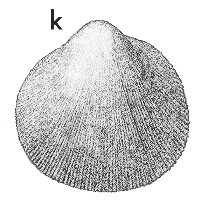
Revised descriptions of New Zealand Cenozoic Mollusca from Beu and Maxwell (1990)

 | Revised descriptions of New Zealand Cenozoic Mollusca from Beu and Maxwell (1990) | 
|
  (Pl. 46k): Castlecliff, Wanganui, Castlecliffian (GNS, from an old collection) |
Beu & Maxwell (1990): Chapter 16; p. 343; pl. 46 k.
Synonymy: Cardium pulchellum Gray 1843, p. 252; Protocardia pulchella; Nemocardium pulchellum; Nemocardium (Pratulum) pulchellum, Beu & Maxwell 1990, p. 343, pl. 46k.
Classification: Cardiidae: Protocardiinae
Description: Very small for family (25-30 mm long), very thin and fragile, strongly inflated, slightly longer than high, very finely sculptured. Umbones low, slightly in front of centre. Flanks and anterior sculptured with low, wide radial costae with almost smooth, lightly polished, convex surfaces, interspaces half width of 1 costa; about 3 per mm at 10 mm from umbo; crossed by very thin, low, widely spaced commarginal lamellae over distal third of shell. Posterior area about a quarter of length, demarcated from flank by narrow groove and 1 very narrow radial costa, remainder of posterior sculptured with narrower, more widely spaced radial costae than on flanks, each costa bearing a row of small, sharp nodules on well preserved specimens; on some specimens, nodules of each fourth or fifth costa are more prominent than on their neighbours. Lunule a very narrow, smooth area above anterior hinge, not otherwise demarcated; escutcheon similar to lunule, almost smooth, elevated in right valve but depressed in left valve. Ventral margin crenulate. Hinge very thin and narrow, with a small, peg- like cardinal tooth and corresponding socket in each valve, a very small second, anterior cardinal tooth in right valve, a thin lateral tooth on each hinge extremity in left valve, and a corresponding socket and thin lateral tooth on each hinge extremity in right valve. Adductor muscle scars small, oval, weakly impressed; pallial line a broad, weakly impressed band with 2 very shallow inflections below posterior adductor scar.
Comparison: Pratulum pulchellum lives commonly today in soft, fine-grained sediments in a wide range of habitats and depths, from small bays within large harbours to the outer shelf, and from about 5 m to at least 200 m, and empty valves are commonly dredged in up to 500 m and more. It is not surprising, then, that it is one of the most ubiquitous fossil molluscs in offshore siltstone of Pleistocene and late Pliocene age throughout New Zealand. As with the possibly ancestral species P. quinarium (Pl. 34c; Tongaporutuan (?)-Waipipian), it seems to be an indicator of fine-grained, unconsolidated substrates rather than any particular depth range. The earlier Pliocene Pratulum species are compared with P. pulchellum under P. quinarium (Pl. 34c). The species group has inhabited New Zealand since at least Early Paleocene time (P. modicum, Wangaloan) and the extinction of the last of the large, spectacular mid-Cenozoic Cardiidae (Maoricardium spatiosum and Trachycardium rossi, during Mangapanian and early Nukumaruan time, respectively) left P. pulchellum as the sole cardiid remaining in New Zealand. Pratulum is clearly an Australasian genus of small Protocardiinae, well separated from the large species of Nemocardium (Poutiers 1992).
Distribution: Mangapanian-Recent. Recent, New Zealand (type).
Cite this publication as: "A.G. Beu and J.I. Raine (2009). Revised
descriptions of New Zealand Cenozoic Mollusca from Beu and Maxwell (1990). GNS
Science miscellaneous series no. 27."
© GNS Science, 2009
ISBN
978-0-478-19705-1
ISSN 1177-2441
(Included with a PDF facsimile file
copy of New Zealand Geological Survey Paleontological Bulletin 58 in CD version
from: Publications Officer, GNS Science, P.O. Box 30368 Lower Hutt, New
Zealand)